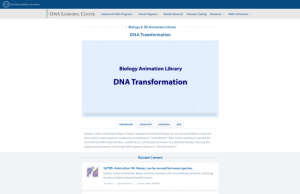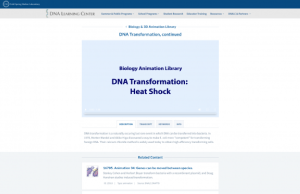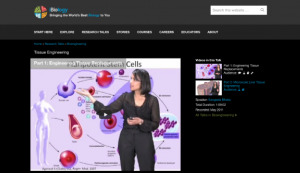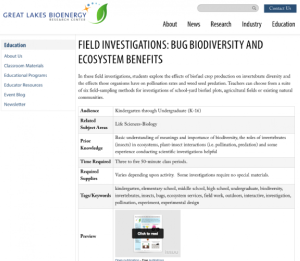Browse Resources
(19 classifications) (68 resources)
| Activity (415) Case Study (52) Course (244) Curriculum (118) Demonstration (106) Experiment/Lab Activity (434) Game (10) Instructor Guide/Manual (412) Interactive Simulation (124) |
Lecture/Presentation (1,763) Lesson/Lesson Plan (404) Model (2) Problem Set (50) Project (3) Student Guide (240) Syllabus (137) Textbook (88) Tutorial (132) Unit of Instruction (128) |
Resources | |
|---|---|
This animation from Cold Spring Harbor Laboratory's Dolan DNA Learning Center presents DNA arrays. The animation contains information on Pat Brown's discovery and the purpose of DNA arrays to study gene expression as well as its role in the development of pharmacogenomic treatment for diseases such...
The discovery of enzymes that could cut and paste DNA made genetic engineering possible. Restriction enzymes, found naturally in bacteria, can be used to cut DNA fragment at specific sequences, while another enzyme, DNA ligase, can attach or rejoin DNA fragments with complementary ends. This...
Stanley Cohen and Herbert Boyer's historic experiment used techniques to cut and paste DNA to create the first custom-made organism containing recombined or 'recombinant' DNA. Cohen and Boyer inserted the recombinant DNA molecule they created into E. coli bacteria by means of a plasmid, thereby...
DNA transformation is a naturally occurring but rare event in which DNA can be transferred into bacteria. In 1970, Morton Mandel and Akiko Higa discovered a way to make E. coli more 'competent' for transforming foreign DNA. Their calcium chloride method is widely used today to obtain high-efficiency...
Two sequencing techniques were developed independently in the 1970s. The method developed by Fred Sanger used chemically altered 'dideoxy' bases to terminate newly synthesized DNA fragments at specific bases (either A, C, T, or G). These fragments are then size-separated, and the DNA sequence can be...
This lecture from the iBioSeminars project is presented by Sangeeta Bhatia from the Massachusetts Institute of Technology and the Howard Hughes Medical Institute covers the concept of engineering tissues that are part cell and part synthetic material, proposed nearly 20 years ago. This lecture...
This lecture from the iBioSeminars project is presented by Eva Nogales Molecular Cell Biology Professor at the University of California, Berkeley, and it covers Visualizing Biological Structure Using Electron Microscopy: From Molecules to Cells. Transmission electron microscopy (TEM) offers the...
This lecture from the iBioSeminars project is presented by Brian Druker of HHMI and the Oregon Health & Science University Cancer Institute. It describes the lessons learned from the clinical trials of imatinib. This will include examples of where imatinib has or has not worked, analysis of target...
Students will discover the relationship between biofuel crop production and invertebrate biodiversity in these field investigations as well as the "effects those organisms have on pollination rates and weed seed predation." Instructors will have the option to choose from six field-sampling methods...
Lia Kent, of Stemgent's Research and Development team, has created this video to demonstrate "the proper technique for rapidly thawing hES cells from liquid nitrogen stocks, plating them on mouse embryonic feeder cells, and slowly freezing them for long-term storage." The video is also accompanied...
| |
| ← Previous | Next → |









